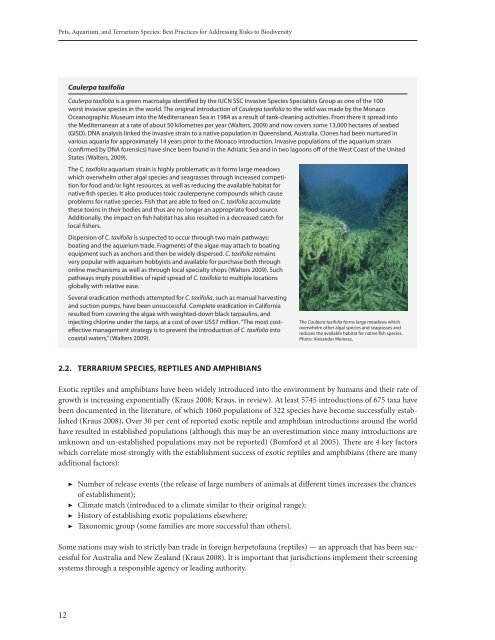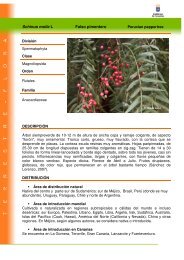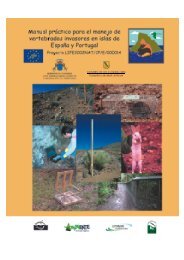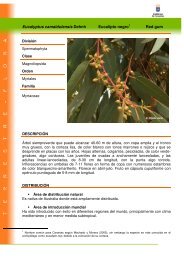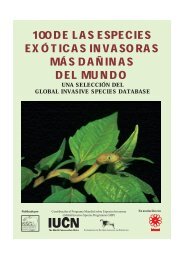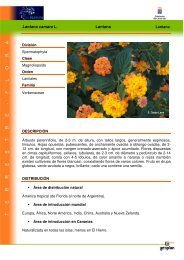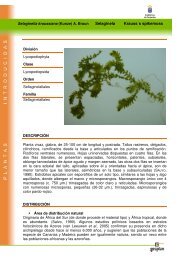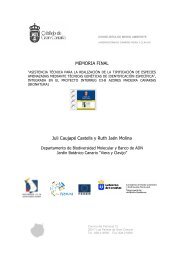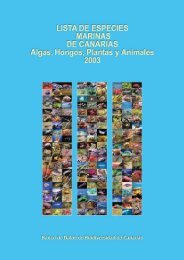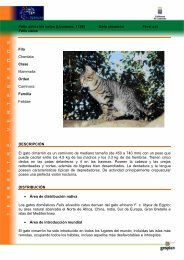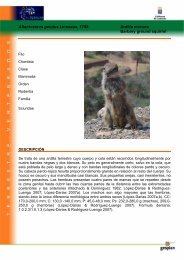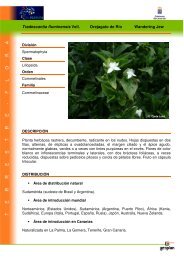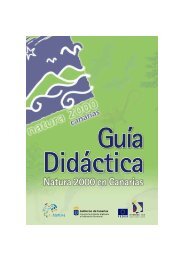Pets, Aquarium, and Terrarium Species - Convention on Biological ...
Pets, Aquarium, and Terrarium Species - Convention on Biological ...
Pets, Aquarium, and Terrarium Species - Convention on Biological ...
Create successful ePaper yourself
Turn your PDF publications into a flip-book with our unique Google optimized e-Paper software.
<str<strong>on</strong>g>Pets</str<strong>on</strong>g>, <str<strong>on</strong>g>Aquarium</str<strong>on</strong>g>, <str<strong>on</strong>g>and</str<strong>on</strong>g> <str<strong>on</strong>g>Terrarium</str<strong>on</strong>g> <str<strong>on</strong>g>Species</str<strong>on</strong>g>: Best Practices for Addressing Risks to Biodiversity<br />
Caulerpa taxifolia<br />
Caulerpa taxifolia is a green macroalga identified by the IUCN SSC Invasive <str<strong>on</strong>g>Species</str<strong>on</strong>g> Specialists Group as <strong>on</strong>e of the 100<br />
worst invasive species in the world. The original introducti<strong>on</strong> of Caulerpa taxifolia to the wild was made by the M<strong>on</strong>aco<br />
Oceanographic Museum into the Mediterranean Sea in 1984 as a result of tank-cleaning activities. From there it spread into<br />
the Mediterranean at a rate of about 50 kilometres per year (Walters, 2009) <str<strong>on</strong>g>and</str<strong>on</strong>g> now covers some 13,000 hectares of seabed<br />
(GISD). DNA analysis linked the invasive strain to a native populati<strong>on</strong> in Queensl<str<strong>on</strong>g>and</str<strong>on</strong>g>, Australia. Cl<strong>on</strong>es had been nurtured in<br />
various aquaria for approximately 14 years prior to the M<strong>on</strong>aco introducti<strong>on</strong>. Invasive populati<strong>on</strong>s of the aquarium strain<br />
(c<strong>on</strong>firmed by DNA forensics) have since been found in the Adriatic Sea <str<strong>on</strong>g>and</str<strong>on</strong>g> in two lago<strong>on</strong>s off of the West Coast of the United<br />
States (Walters, 2009).<br />
The C. taxifolia aquarium strain is highly problematic as it forms large meadows<br />
which overwhelm other algal species <str<strong>on</strong>g>and</str<strong>on</strong>g> seagrasses through increased competiti<strong>on</strong><br />
for food <str<strong>on</strong>g>and</str<strong>on</strong>g>/or light resources, as well as reducing the available habitat for<br />
native fish species. It also produces toxic caulerpenyne compounds which cause<br />
problems for native species. Fish that are able to feed <strong>on</strong> C. taxifolia accumulate<br />
these toxins in their bodies <str<strong>on</strong>g>and</str<strong>on</strong>g> thus are no l<strong>on</strong>ger an appropriate food source.<br />
Additi<strong>on</strong>ally, the impact <strong>on</strong> fish habitat has also resulted in a decreased catch for<br />
local fishers.<br />
Dispersi<strong>on</strong> of C. taxifolia is suspected to occur through two main pathways:<br />
boating <str<strong>on</strong>g>and</str<strong>on</strong>g> the aquarium trade. Fragments of the algae may attach to boating<br />
equipment such as anchors <str<strong>on</strong>g>and</str<strong>on</strong>g> then be widely dispersed. C. taxifolia remains<br />
very popular with aquarium hobbyists <str<strong>on</strong>g>and</str<strong>on</strong>g> available for purchase both through<br />
<strong>on</strong>line mechanisms as well as through local specialty shops (Walters 2009). Such<br />
pathways imply possibilities of rapid spread of C. taxifolia to multiple locati<strong>on</strong>s<br />
globally with relative ease.<br />
Several eradicati<strong>on</strong> methods attempted for C. taxifolia, such as manual harvesting<br />
<str<strong>on</strong>g>and</str<strong>on</strong>g> sucti<strong>on</strong> pumps, have been unsuccessful. Complete eradicati<strong>on</strong> in California<br />
resulted from covering the algae with weighted-down black tarpaulins, <str<strong>on</strong>g>and</str<strong>on</strong>g><br />
injecting chlorine under the tarps, at a cost of over US$7 milli<strong>on</strong>. “The most costeffective<br />
management strategy is to prevent the introducti<strong>on</strong> of C. taxifolia into<br />
coastal waters,” (Walters 2009).<br />
The Caulpera taxifolia forms large meadows which<br />
overwhelm other algal species <str<strong>on</strong>g>and</str<strong>on</strong>g> seagrasses <str<strong>on</strong>g>and</str<strong>on</strong>g><br />
reduces the available habitat for native fish species.<br />
Photo: Alex<str<strong>on</strong>g>and</str<strong>on</strong>g>er Meinesz.<br />
2.2. <str<strong>on</strong>g>Terrarium</str<strong>on</strong>g> <str<strong>on</strong>g>Species</str<strong>on</strong>g>, Reptiles <str<strong>on</strong>g>and</str<strong>on</strong>g> Amphibians<br />
Exotic reptiles <str<strong>on</strong>g>and</str<strong>on</strong>g> amphibians have been widely introduced into the envir<strong>on</strong>ment by humans <str<strong>on</strong>g>and</str<strong>on</strong>g> their rate of<br />
growth is increasing exp<strong>on</strong>entially (Kraus 2008; Kraus, in review). At least 5745 introducti<strong>on</strong>s of 675 taxa have<br />
been documented in the literature, of which 1060 populati<strong>on</strong>s of 322 species have become successfully established<br />
(Kraus 2008). Over 30 per cent of reported exotic reptile <str<strong>on</strong>g>and</str<strong>on</strong>g> amphibian introducti<strong>on</strong>s around the world<br />
have resulted in established populati<strong>on</strong>s (although this may be an overestimati<strong>on</strong> since many introducti<strong>on</strong>s are<br />
unknown <str<strong>on</strong>g>and</str<strong>on</strong>g> un-established populati<strong>on</strong>s may not be reported) (Bomford et al 2005). There are 4 key factors<br />
which correlate most str<strong>on</strong>gly with the establishment success of exotic reptiles <str<strong>on</strong>g>and</str<strong>on</strong>g> amphibians (there are many<br />
additi<strong>on</strong>al factors):<br />
▶▶<br />
Number of release events (the release of large numbers of animals at different times increases the chances<br />
of establishment);<br />
▶▶<br />
Climate match (introduced to a climate similar to their original range);<br />
▶▶<br />
History of establishing exotic populati<strong>on</strong>s elsewhere;<br />
▶▶<br />
Tax<strong>on</strong>omic group (some families are more successful than others).<br />
Some nati<strong>on</strong>s may wish to strictly ban trade in foreign herpetofauna (reptiles) — an approach that has been successful<br />
for Australia <str<strong>on</strong>g>and</str<strong>on</strong>g> New Zeal<str<strong>on</strong>g>and</str<strong>on</strong>g> (Kraus 2008). It is important that jurisdicti<strong>on</strong>s implement their screening<br />
systems through a resp<strong>on</strong>sible agency or leading authority.<br />
12


